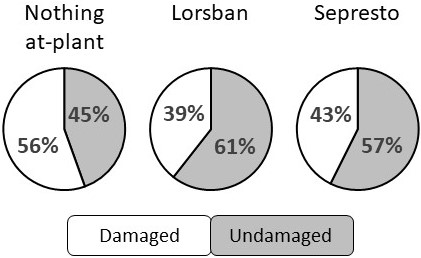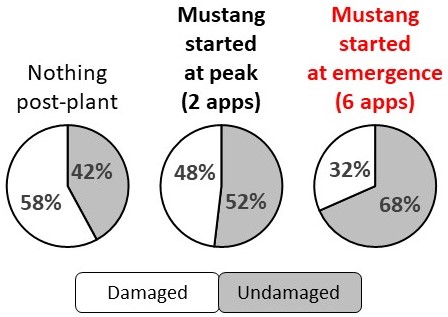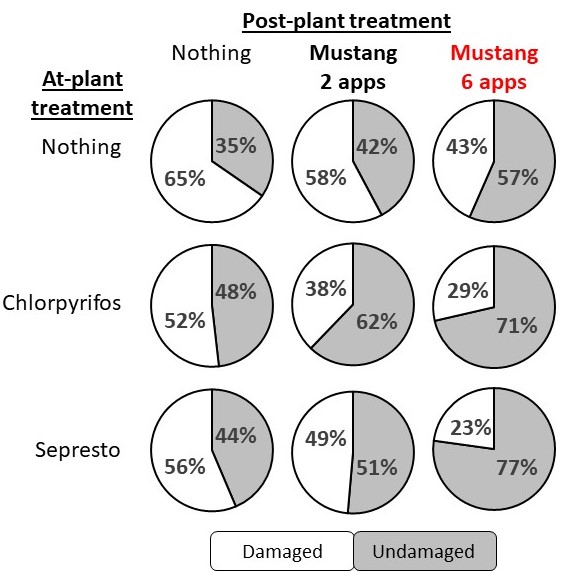The quest for Lorsban alternatives for cabbage maggot control in brassica root crops: 2019 trials
Cabbage maggot is a difficult pest to control in turnips, radishes and rutabagas. Learn the latest results from the 2019 MSU insecticide trials aiming to hunt down Lorsban alternatives.

Cabbage maggot is a difficult-to-control pest of brassica root crops that has historically been controlled with at-plant chlorpyrifos (tradename Lorsban) applications. Cabbage maggot flies, which look like houseflies, lay eggs in the soil around the base of radish, rutabaga and turnip plants (Fig. 1). The eggs hatch into tiny maggots that tunnel in the roots, making them unmarketable.
In 2018 trials, we found that chlorpyrifos, the Sepresto seed treatment and Mustang Maxx reduced maggot damage in. We further explored different combinations of these at- and post-plant insecticides for cabbage maggot control in 2019 (Table 1). The trial was in a field of turnips planted in a sandy-loam soil on March 28 in Hudsonville, Michigan.
|
Table 1. Insecticides tested for control of cabbage maggot in turnips. | ||||
|---|---|---|---|---|
|
Insecticide (formulation) |
Active ingredient |
Insecticide class |
Labelled? |
Rate |
|
Chlorpyrifos 15G (granular) |
chlorpyrifos |
Organophosphate |
Yes |
Grower-standard |
|
Sepresto (seed treatment) |
clothianidin + imidacloprid |
Neonicotinoid |
No |
0.1 mg active ingredient per seed |
|
Mustang Maxx (liquid) |
zeta-cypermethrin |
Pyrethroid |
Yes |
4.0 fluid ounces per acre |
Planting-time products
To test planting-time insecticides, our cooperator planted 15 planter passes of turnips that were 240 feet long. Turnips were protected with nothing (at-plant controls), in-furrow applications of Chlorpyrifos 15G or the Sepresto seed treatment (applied by the Cornell University seed technology lab).
We rated the percentage of turnips with maggot tunneling in each plot 84 days after planting. (View the statistical analysis results.) The grower standard chlorpyrifos was the best performing at-plant treatment, reducing damage by 17% compared to controls (Fig. 2). Damage was 13% less with Sepresto-treated seed, but this difference was not statistically significant (Fig. 2). Better control was achieved when Sepresto was combined with post-plant foliar insecticide applications (Fig 5).

Our grower cooperator noted that Sepresto appeared to reduce turnip stands in 2018. We did stand counts 96 days after planting in 2019 to investigate this. Sepresto treatment at 0.1 mg active ingredient per seed reduced stands by 30%, from about six to four plants per foot. Total weight of turnips did not differ. This was because turnips were larger in plots with lower stands. Future work could investigate if a lower rate of Sepresto can provide suppression without reducing plant stands.
Post-plant applications
The spring flight of cabbage maggot typically lasts for three to five weeks spanning early May to early June. Fly activity peaks for seven to 10 days during this time, based on degree-days over 2014-2019 at the Fennville, Hudsonville and Kent City Enviroweather stations. In 2018, we used a degree-day tool to target two applications of Mustang Maxx during this window of peak activity. Our goal was to delay applications until peak-flight as an efficient way to gain control while reducing costs. These two applications did reduce damage. However, they were not enough to provide standalone control.
Could growers obtain better control by starting Mustang Maxx applications earlier?
We tested this in 2019 by dividing each 240-foot long planter-pass into three 80-foot sections. Each section was treated with either nothing (controls), weekly applications delayed until the week of peak flight, or weekly applications started when flies first emerged (Fig. 3). In all cases, we stopped applying insecticides once the spring flight ended. We timed applications using a degree-day model available on Enviroweather.

Control was significantly better when weekly insecticide applications began as soon as fly emergence started. In total, we made six Mustang Maxx applications from May 6 to June 11 in these plots (Fig. 3). This reduced damage by 26% compared to the control (Fig. 4). In contrast, damage was only 10% less than controls when we delayed application until peak flight (Fig. 4).

Treatment combinations
Our experimental design allowed us to examine how different combinations of at- and post-plant insecticides performed for maggot control. The best three combinations, in order of efficacy, were Sepresto plus Mustang Maxx started at emergence (23% turnips damaged), Chorpyrifos 15G plus Mustang Maxx started at emergence (29% damaged), and Chlorpyrifos 15G plus Mustang Maxx started at peak (38% damaged; Fig. 5). On average, 65% of turnips were damaged in plots with no insecticide.

Of the labeled alternatives to chlorpyrifos, Mustang Maxx has provided the best control across two years of research. However, under the high pressure at the study site—where turnips have been planted in four consecutive years— it did not provide sufficient control on its own. Just like in 2018, in 2019 it took combinations of at- and post-plant treatments to approach acceptable control (Fig. 5). For example, on average 52% of turnips were damaged in plots where only chlorpyrifos was used (Fig. 5). Similarly, plots that were only treated with six applications of Mustang Maxx, but nothing at planting time, saw an average of 43% damage. But only 29% of turnips were damaged in plots with chlorpyrifos plus follow-up applications of Mustang Maxx.
What does this mean for growers? In the short term, rotation will remain critical for this pest. Post-plant applications of Mustang Maxx may be a helpful compliment when chlorpyrifos alone is not providing the desired level of control. However, it is not clear if Mustang Maxx can provide standalone control. In the long term, it will be important to continue to explore new chemistries that provide an alternative to chlorpyrifos. At present, there is no effective labeled alternative for planting-time application.
A note on application methods
Good product placement is likely critical with this pest. Flies lay eggs in soil crevices in a small zone around the base of plants. For this reason, our grower collaborator built a small band sprayer for use in our experiments (Fig. 6). Using this sprayer, he applied insecticide in a 9-inch band over the turnip rows (26-inch row spacing). This allowed us to concentrate the active ingredient around the base of plants (see video below).

The video below shows banded application of Mustang Maxx to turnips. Making a banded application allowed for use of a higher water volume and concentration of active ingredient where flies are active. Applications were made at 7 PSI with 140 gallons of water per banded acre (48 gpa broadcast rate).
We want to acknowledge our excellent grower cooperator who has put up with difficult experimental designs in addition to a tough pest!



 Print
Print Email
Email

